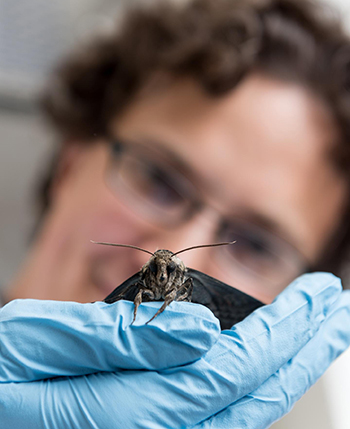
Simon Sponberg holds a hawkmoth—an insect that can slow its brain to improve vision under low-light conditions while continuing to perform demanding tasks. Credit Rob Felt, Georgia Tech
Insights into the sensory and motor processes the hawkmoth (Manduca sexta) uses to see and track flowers in low-light conditions may help engineers design machines that can operate in similar environments. U.S. researchers from the Georgia Institute of Technology, University of Washington and Northwest University used high-speed infrared cameras and swaying robotic flowers to determine how the hummingbird-sized moth is able to slow visual processing to increase light sensitivity in dark conditions without compromising its ability to keep up with the moving flowers (Science, doi: 10.1126/science.aaa3042).
A moth’s compound eye has an adjustable pseudo-pupil that allows refractive eye facets to direct light to a single photoreceptor when they feed on flower nectar at dusk and dawn. Scientists have hypothesized that moths also slow their nervous systems down to more efficiently use the limited light available during these times of day (similar to increasing camera’s exposure time). If this is true, wouldn’t slowing the nervous system reduce the moth’s ability to move with the flowers as they blow in the wind? To answer this question, researchers, led by Georgia Tech’s Simon Sponberg, used high-speed infrared cameras to see if the hawkmoth could keep up with robotic flowers swaying at different rates in low light.
Below is a video of the hawkmoth in action:
{^media|(width)300|(height)200|(ext).mp4|(url)https://www.optica-opn.org/opn/media/Images/Homepage/Newsroom/2015/0615/ScattJun16-movie.mp4^}
A hawkmoth tracks a robotic flower in very dim light. Illumination is infrared. Credit: Science, doi: 10.1126/science.aaa3042
The robotic flowers were programmed to oscillate from 20 Hz (20 times per second) to 2 Hz (the maximum speed researchers observed flowers swaying in nature). The researchers observed that the moths were only able to keep up with the flowers that moved at speeds they would actually encounter in nature. From an evolutionary perspective, the results suggest that the hawkmoth is in tune with its environment—their neural processing slows down just enough to allow the moth to visually track the flower but not so much that it isn’t able to follow the flower as it moves in the breeze.
Understanding the neural circuits that allow animals adapt to different environments could help engineers overcome challenges in designing synthetic vision systems that function in ambient light intensities, which can vary over 10 billion-fold in a single day.
